Cryptolocker can reach the computer in two ways. E-mails and websites were mainly used as a gateway. In the email inbox, users receive an infected attachment. It can be a compressed Zip or Rar file, a Word document or an image in the form of Jpeg. The attackers mainly pose as state institutions, commerce companies, applicants, or business partners.
CryptoLocker is a recent family of ransomare which is based on user extortion. Another famous malware that is also based on extortion is the Police Virus, with which you had to pay to recover your computer. But unlike this, CryptoLocker is based on hijacking the user’s documents and asking for a payment for them.
When the user opens the zip said above, it sneaks into our mail, which is believed to be a PDF file inside but in reality, when the fake PDF is opened, the Trojan is executed. CryptoLocker takes advantage of the Windows policy of hiding extensions by default, in such a way that the user is tricked into this Windows feature.
CryptoLocker can only encrypt files and folders that your user account has access to. If you manage a network, you can help mitigate potential damage by granting users access only to the resources they are likely to need, a configuration known as the least privilege model. However, the best thing to do is:
▸Never download attachments from unknown senders
This would be the main method that CryptoLocker uses to break through to the computers of its victims. Never, under any circumstances, download unknown attachments.
▸Download programs, applications and content only from verified sources
When you download something from an official portal, you benefit from the added security of a pre-check process. Turning to P2P networks to get the content you want can be tempting, but doing it will takes a risk.
▸Always update your software
Install updates and patches as soon as they are released, for both the operating system and other software. They tend to eliminate vulnerabilities that cybercriminals can exploit.
Other interesting reads:
Cryptojacking – A risk that can also damage your PC
Satan – A computer hijacker virus
WannaRen – The day the Ransomware lost




[…] also:CryptoLocker – Unexpected RansomwareWannaRen – The day the Ransomware […]
[…] check:CryptoLocker – Unexpected RansomwareHistory of Ransomware and how it has […]